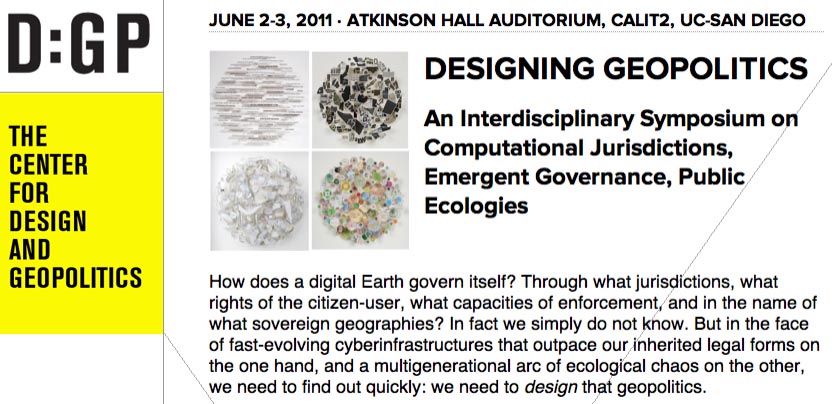I’m heading off soon on a road trip with Nicola Twilley, from Edible Geography, to visit some incredible sites (and sights) around the desert southwest, visiting places where architecture, astronomy, and the planetary sciences, to varying degrees, overlap.
 [Image: The Very Large Array].
[Image: The Very Large Array].
This will be an amazing trip! Our stops include the “world’s largest collection of optical telescopes,” including the great hypotenuse of the McMath-Pierce Solar Telescope, outside Tucson; the Very Large Array in west-central New Mexico; the Controlled Environment Agriculture Center at the University of Arizona, aka the “lunar greenhouse,” where “researchers are demonstrating that plants from Earth could be grown without soil on the moon or Mars, setting the table for astronauts who would find potatoes, peanuts, tomatoes, peppers and other vegetables awaiting their arrival”; the surreal encrustations of the Salton Sea, a site that, in the words of Kim Stringfellow, “provides an excellent example of the the growing overlap of humanmade and natural environments, and as such highlights the complex issues facing the management of ecosystems today”; the Fred Lawrence Whipple Observatory, with its automated scanning systems used for “robotic searches for variable stars and exoplanets” in the night sky, and its gamma-ray reflectors and “blazar lightcurves” flashing nearby; the Grand Canyon; Red Rocks, outside Sedona; the hermetic interiorities of Biosphere 2; White Sands National Monument and the Trinity Site marker, with its so-called bomb glass; the giant aircraft “boneyard” at the Pima Air & Space Museum; and, last but not least, the unbelievably fascinating Lunar Laser-ranging Experiment at Apache Point, New Mexico, where they shoot lasers at prismatic retroreflectors on the moon, testing theories of gravitation, arriving there by way of the nearby Dunn Solar Telescope.
 [Image: The “Electric Aurora,” from Specimens of Unnatural History, by Liam Young].
[Image: The “Electric Aurora,” from Specimens of Unnatural History, by Liam Young].
The ulterior motive behind the trip—a kind of text-based, desert variation on Christian Houge’s study of instrumentation complexes in the Arctic—is to finish up my curator’s essay for the forthcoming Landscape Futures book.
That book documents a forthcoming exhibition at the Nevada Museum of Art called Landscape Futures: Instruments, Devices and Architectural Inventions, featuring work by David Benjamin & Soo-in Yang (The Living), Mark Smout & Laura Allen (Smout Allen), David Gissen, Mason White & Lola Sheppard (Lateral Office), Chris Woebken, and Liam Young.
 Finally, Nicola and I will fall out of the car in a state of semi-delirium in La Jolla, California, where I’ll be presenting at a 2-day symposium on Designing Geopolitics, “an interdisciplinary symposium on computational jurisdictions, emergent governance, public ecologies,” organized by Benjamin Bratton, Daniel Rehn, and Tara Zepel.
Finally, Nicola and I will fall out of the car in a state of semi-delirium in La Jolla, California, where I’ll be presenting at a 2-day symposium on Designing Geopolitics, “an interdisciplinary symposium on computational jurisdictions, emergent governance, public ecologies,” organized by Benjamin Bratton, Daniel Rehn, and Tara Zepel.
That will be free and open to the public, for anyone in the San Diego area who might want to stop by, and it will also be streamed online in its entirety; the full schedule is available at the Designing Geopolitics site.
(Earlier on BLDGBLOG: Landscape Futures Super-Workshop, Landscape Futures Super-Dialogue, and Landscape Futures Super-Media).

No mention of Spaceport America in the Jornada de Muerto of south central New Mexico?
So close but so far! We'll have to miss that, I'm afraid, but I look forward to seeing it some year when it's fully operational.
Geoff — you should check out Patrick Nagatani's book Nuclear Enchantment, a sort of psychocultural guidebook to New Mexico's nuclear 'heritage.' And if y'r going through Albuquerque, you could visit the National Atomic Museum.
I have to say, this blog would be a lot more interesting if the images would link to the large originals, and not only contain tiny thumbnails with links to only the root site of the source.
Dont forget to see: http://www.titanmissilemuseum.org/
"The Titan Missile Museum is the only publicly accessible Titan II missile site in the nation. Tour the underground missile site. See the 3-ton blast doors, the 8-foot thick silo walls, and an actual Titan II missile in the launch duct. Visit the launch control center, experience a simulated launch and more!"
I would say, add canyon de chelly
the Nuclear museum in Vegas ( see Liebeskind retail as well )
http://mojavemainer.wordpress.com/